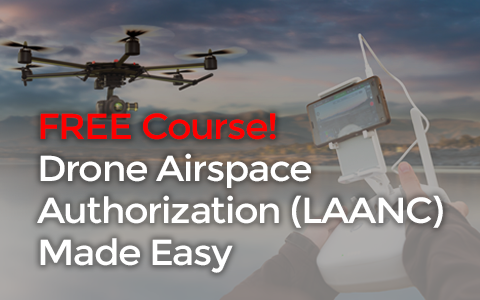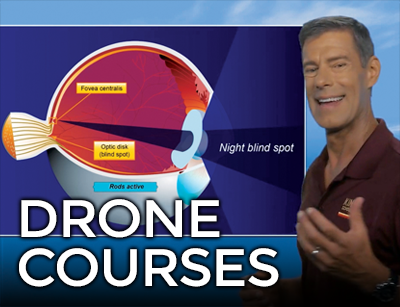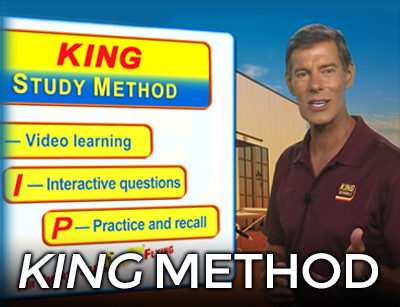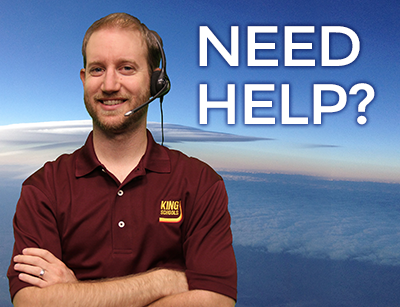ACS Missed Question Codes - Drone (Part 107)
FAA Missed ACS Codes
for Unmanned Aircraft Systems Exams
Drone (Part 107) ACS Exams
Got some missed questions on your part 107 written test? No worries, it happens to all of us. If the codes listed on your test results start with "UA", you're in the right place. Your Drone Pilot ACS (Airman Certification Standards) missed question codes will be listed below, and you can see which subject areas to study more. Keep in mind, you won't know exactly which questions you got wrong, only the general subjects missed of the UAS ACS.
If you missed any questions on your FAA Knowledge Test, you will find the Airman Certification Standards codes on your test report.
Click Here to view, and if desired, download, your ACS document.
ACS Code
Knowledge Area
UA.I.A.K1
Applicability of 14 CFR part 107 to small unmanned aircraft operations.
UA.I.A.K2
Definitions used in 14 CFR part 107.
UA.I.A.K3
The ramifications of falsification, reproduction, or alteration of a certificate, rating, authorization, record, or report.
UA.I.A.K4
Accident Reporting.
UA.I.A.K5 I
Inspection, testing, and demonstration of compliance.
UA.I.B.K1
Registration requirements for sUAS.
UA.I.B.K2
Requirement for the sUAS to be in a condition for safe operation.
UA.I.B.K3
Medical condition(s) that would interfere with safe operation of an sUAS.
UA.I.B.K4
Responsibility and authority of the remote PIC.
UA.I.B.K4a
a. Allowing a person other than the remote PIC to manipulate the flight controls.
UA.I.B.K5
Regulatory deviation and reporting requirements for in-flight emergencies.
UA.I.B.K6
Hazardous operations.
UA.I.B.K6a
a. Careless or reckless
UA.I.B.K6b
b. Dropping an object
UA.I.B.K7
Operating from a moving aircraft or moving land- or water-borne vehicle.
UA.I.B.K8
Alcohol or drugs and the provisions on prohibition of use.
UA.I.B.K9
Daylight operation.
UA.I.B.K10
Visual line of sight (VLOS) aircraft operations.
UA.I.B.K11
Requirements when a visual observer is used.
UA.I.B.K12
Prohibition of operating multiple sUAS.
UA.I.B.K13
Prohibition of carrying hazardous material.
UA.I.B.K14
Staying safely away from other aircraft and right-of-way rules.
UA.I.B.K14a
a. See and avoid other aircraft and other potential hazard considerations of the remote PIC
UA.I.B.K15
Operations over human beings.
UA.I.B.K16
Prior authorization required for operation in certain airspace.
UA.I.B.K17
Operating in the vicinity of airports.
UA.I.B.K18
Operating in prohibited or restricted areas.
UA.I.B.K19
Flight restrictions in the proximity of certain areas designated by notice to airmen (NOTAM).
UA.I.B.K20
Preflight familiarization, inspection, and actions for aircraft operations.
UA.I.B.K21
Operating limitations for sUAS.
UA.I.B.K21a
a. Maximum groundspeed
UA.I.B.K21b
b. Altitude limitations
UA.I.B.K21c
c. Minimum visibility
UA.I.B.K21d
d. Cloud clearance requirements
UA.I.B.K22
Requirements for a Remote Pilot Certificate with an sUAS rating.
UA.I.D.K1
Waiver policy and requirements.
UA.II.A.K1
General airspace
UA.II.A.K1a
a. Class B controlled airspace
UA.II.A.K1b
b. Class C controlled airspace
UA.II.A.K1c
c. Class D controlled airspace
UA.II.A.K1d
d. Class E controlled airspace
UA.II.A.K1e
e. Class G uncontrolled airspace
UA.II.A.K2
Special-use airspace, such as prohibited, restricted, warning areas, military operation areas, alert areas, and controlled firing areas.
UA.II.A.K3
Other airspace areas, such as Airport Advisory Services, Military Training Routes (MTRs), Temporary Flight Restrictions (TFRs), Parachute Jump Operations, Terminal Radar Service Areas (TRSAs), National Security Areas (NSA) and Visual Flight Rules (VFR) ro
UA.II.A.K4
Air Traffic Control (ATC) and the NAS.
UA.II.B.K1
Basic weather minimums.
UA.II.B.K2
ATC authorizations and related operating limitations.
UA.II.B.K3
Operations near airports.
UA.II.B.K4
Potential flight hazards.
UA.II.B.K4a
a. Common aircraft accident causal factors
UA.II.B.K4b
b. Avoid flight beneath unmanned balloons
UA.II.B.K4c
c. Emergency airborne inspection of other aircraft
UA.II.B.K4d
d. Precipitation static
UA.II.B.K4e
e. Light amplification by stimulated emission of radiation (laser) operations and reporting illumination of aircraft
UA.II.B.K4f
f. Avoiding flight in the vicinity of thermal plumes, such as smoke stacks and cooling towers
UA.II.B.K4g
g. Flying in the wire environment
UA.II.B.K5
The NOTAM system including how to obtain an established NOTAM through Flight Service.
UA.III.A.K1
Internet weather briefing and sources of weather available for flight planning purposes.
UA.III.A.K2
Aviation routine weather reports (METAR).
UA.III.A.K3
Terminal aerodrome forecasts (TAF).
UA.III.A.K4
Weather charts.
UA.III.A.K5
Automated surface observing systems (ASOS) and automated weather observing systems (AWOS).
UA.III.B.K1
Weather factors and their effects on performance:
UA.III.B.K1a
a. Density altitude
UA.III.B.K1b
b. Wind and currents
UA.III.B.K1c
c. Atmospheric stability, pressure, and temperature
UA.III.B.K1d
d. Air masses and fronts
UA.III.B.K1e
e. Thunderstorms and microbursts
UA.III.B.K1f
f. Tornadoes
UA.III.B.K1g
g. Icing
UA.III.B.K1h
h. Hail
UA.III.B.K1i
i. Fog
UA.III.B.K1j
j. Ceiling and visibility
UA.III.B.K1k
k. Lightning
UA.IV.A.K1
General loading and performance:
UA.IV.A.K1a
a. Effects of loading changes
UA.IV.A.K1b
b. Balance, stability, and center of gravity
UA.IV.A.K2
Importance and use of performance data to calculate the effect on the aircraft’s performance of an sUAS.
UA.V.A.K1
Airport operations with and without an operating control tower.
UA.V.A.K2
The description and use of a Common Traffic Advisory Frequency (CTAF) to monitor manned aircraft communications.
UA.V.A.K3
Recommended traffic advisory procedures used by manned aircraft pilots, such as selfannouncing of position and intentions.
UA.V.A.K4
Aeronautical advisory communications station (UNICOM) and associated communication procedures used by manned aircraft pilots.
UA.V.A.K5
Automatic Terminal Information Service (ATIS).
UA.V.A.K6
Aircraft call signs and registration numbers.
UA.V.A.K7
The phonetic alphabet.
UA.V.A.K8
Phraseology: altitudes, directions, speed, and time.
UA.V.B.K1
Types of airports, such as towered, uncontrolled towered, heliport, and seaplane bases.
UA.V.B.K2
ATC towers, such as ensuring the remote pilot can monitor and interpret ATC communications to improve situational awareness.
UA.V.B.K3
Runway markings and signage.
UA.V.B.K4
Traffic patterns used by manned aircraft pilots.
UA.V.B.K5
Security Identification Display Areas (SIDA).
UA.V.B.K6
Sources for airport data:
UA.V.B.K6a
a. Aeronautical charts
UA.V.B.K6b
b. Chart Supplements
UA.V.B.K7
Avoiding bird and wildlife hazards and reporting collisions between aircraft and wildlife.
UA.V.C.K1
Emergency planning and communication.
UA.V.C.K2
Characteristics and potential hazards of lithium batteries:
UA.V.C.K2a
a. Safe transportation, such as proper inspection and handling
UA.V.C.K2b
b. Safe charging
UA.V.C.K2c
c. Safe usage
UA.V.C.K2d
d. Risks of fires involving lithium batteries
UA.V.C.K3
Loss of aircraft control link and fly-aways.
UA.V.C.K4
Loss of Global Positioning System (GPS) signal during flight and potential consequences.
UA.V.C.K5
Frequency spectrums and associated limitations.
UA.V.D.K1
Aeronautical Decision-Making (ADM):
UA.V.D.K1a
a. Effective team communication
UA.V.D.K1b
b. Task management
UA.V.D.K2
Crew Resource Management (CRM).
UA.V.D.K3
Situational awareness.
UA.V.D.K4
Hazardous attitudes.
UA.V.D.K5
Hazard identification and risk assessment.
UA.V.E.K1
Physiological considerations and their effects on safety, such as dehydration and heatstroke.
UA.V.E.K2
Drug and alcohol use.
UA.V.E.K3
Prescription and over-the-counter medication.
UA.V.E.K4
Hyperventilation.
UA.V.E.K5
Stress and fatigue.
UA.V.E.K6
Factors affecting vision.
UA.V.E.K7
Fitness for flight.
UA.V.F.K1
Basic maintenance.
UA.V.F.K2
Preflight inspection.
UA.V.F.K3
Techniques to mitigate mechanical failures of all elements used in sUAS operations, such as the battery and/or any device(s) used to operate the sUAS.
UA.V.F.K4
Appropriate record keeping.
UA.V.F.K5
Persons that may perform maintenance on an sUAS.













